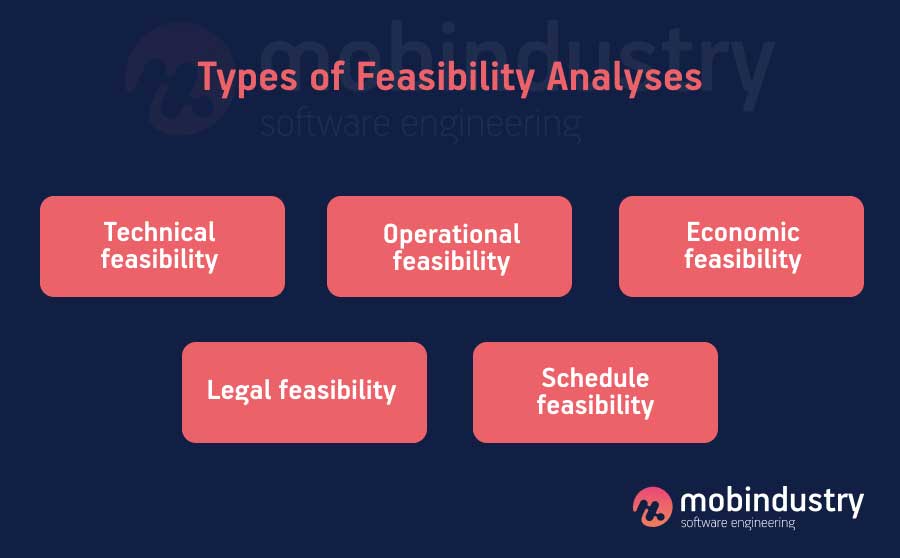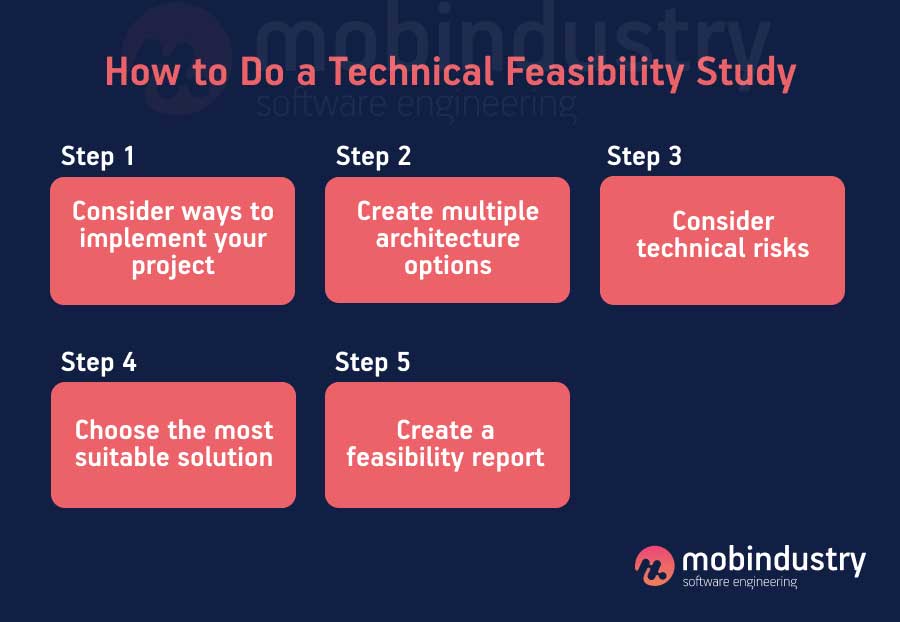Month: February 2022
How to Conduct the Technical Feasibility Analysis in Software Development
Feasibility is one of the four stages in the project management lifecycle. It determines the ability of a business to create software, and miscalculations in a technical feasibility analysis often lead to complete project failure.
Let’s find out how to calculate your project’s feasibility and make sure your product launches successfully!
What is feasibility in software engineering?
Feasibility in software development measures how beneficial software will be for the company from a practical standpoint. A feasibility study in software engineering is an important part of the planning process that shows not only future benefits that software will bring to the business but also the ability of the business to develop such software effectively with their current resources.
Feasibility is essentially the difference between what’s being invested against the profit that a business can get from that investment. In the software development process, there are several types of feasibility analyses or feasibility studies.
Types of feasibility analyses
It’s important to conduct all kinds of feasibility studies before you start developing your product, as they reflect feasibility in different areas of your business. Let’s look at types of feasibility in detail.

Technical feasibility analyzes the current resources available for development, which include technology, technical specialists, and hardware and software required for development.
A technical feasibility study determines whether the team has enough skills and resources to develop your software with a certain tech stack and considers not only the current state of your chosen technology but also the future maintainability and scalability of your product.
Operational feasibility determines how easy it will be to use, maintain, and operate the software after it’s deployed. For example, if you create software for your staff to improve and automate internal operations, you need to make sure that it will be convenient for your staff to use this software in the long run and that it will benefit their work process.
Economic feasibility compares the costs and benefits of the project. To determine economic feasibility, you need an extremely detailed estimate for your project development that includes everything from your developers’ salaries and hardware to future maintenance and recurring costs of third-party services.
All these expenses should then be compared against the predicted revenue and benefit for your organization.
Legal feasibility analyzes the legal requirements for your software and determines whether your company is able to comply with them. This is especially important with healthcare and financial software products that are highly regulated.
Many entrepreneurs avoid building certain features like access to EHR systems in mHealth apps or cryptocurrency operations in FinTech apps because it’s too expensive to comply with requirements.
Schedule feasibility evaluates the time needed to complete a project. Time can be a crucial factor for an organization, and the inability to complete a project on time may jeopardize its success. For example, if you plan to build an application for a specific event, you need to make sure that you’re able to build it before the event happens. Otherwise, all the efforts will be wasted.
In this article, I’ll mostly be talking about technical feasibility because it’s exactly what your outsourcing vendor can help you calculate. However, we can consult you on all other types of feasibility, including operational feasibility and legal feasibility.
Let’s now talk about technical feasibility in software development life cycle in more detail.
What is technical feasibility?
Technical feasibility considers the current resources of your company or development team, which include:
- Hardware
- Software
- Technology
- Software development tools
- Specialists
- Skills and knowledge
- Time and budget for development
Technical feasibility takes into consideration the technical skills of development team members and makes sure the technologies picked for a certain product are sufficient, reliable, and suitable for the market.
Let me give you an example of the factors you need to take into account when assessing the technical feasibility of a certain technology.
Some technologies that seem feasible at the time may not be best for you in the long run.
There is a multitude of technologies available for development, including new technologies. While certain technologies may be more suitable for your project from the technical perspective, they may not have enough support in the development community. This means that it will be hard for you to find new developers, which may harm your budget, deadlines, and so on.
Some technologies that seem feasible at the time may not be best for you in the long run.
How can you calculate your project’s technical feasibility? Let’s dive in.
How to do a technical feasibility study: a step-by-step guide
A technical feasibility study in software engineering happens at the planning stage of a project and determines the likelihood of successful implementation of software from the technical standpoint.
A technical feasibility study can’t be done in a couple of days, as it requires in-depth analysis of all aspects of your project. That’s why before you start doing this study, you need to know:
- Functional requirements, which are gathered by a business analyst and turned into a technical specification
- Non-functional requirements that are defined by a software architect and determine the product’s technical properties, such as scalability, performance, and localization
Determining the technical requirements for the project is a “zero stage” you need to go through before starting the technical feasibility study. Apart from this, you also need to have an understanding of:
- All hardware and software needed to complete the project
- Risks and constraints
- Compatibility with existing software
- Skills and capabilities of your technical team
Once you have this information, it’s time to assess the project’s feasibility.

Step 1. Consider different ways to implement your project
There are several ways to go about getting software for your business, and your choice will depend on the results of your feasibility study. However, it’s important to keep these options in mind at the very start. What are they?
Avoid implementing software altogether. This is a viable option that’s not that rare. Sometimes, after calculating the feasibility, you find that the costs of implementing new software just aren’t worth it, and it’s best to keep your old system for now. Sometimes you need to wait for the right time or situation to make a shift to new software.
Choosing an off-the-shelf solution with further customization. This option is great if you don’t have enough time and budget to develop your own custom software and your project requirements are not too high such that a ready solution is insufficient.
Choosing an off-the-shelf product is the best option for CRMs and other complex systems that have complex infrastructure that’s too costly for a single business to develop and maintain. With a SaaS solution, you not only get a product that’s ready for customization but also often get 24/7 support and maintenance. Here are the factors you need to consider when choosing a third-party solution:
- Performance
- Reliability
- Customization possibilities
- Monthly or yearly cost
- Compatibility with your current software
- Licencing and compliance with legal requirements
- Access to support
- Scalability
- Ease of learning and implementation
Even if you get ready software, you still need to implement and test APIs, make sure your new software is compatible with your current system, and adjust the code according to your needs. You also need to invest in training your personnel.
Off-the-shelf software has its downsides as well, which include limited customization, dependence on a third-party company, and the need to adjust your internal business processes to the software you’re using.
Often, businesses find that third-party solutions require too much customization, have too many unnecessary features, or lack features a business needs. In this case, it’s best to build a custom solution.
Building a custom solution. After analyzing all SaaS products on the market, you may decide that building a custom solution is the best option for your business. Custom software is in your full control and reflects your unique business processes and needs. You don’t have to compromise with decisions made by another company, and you can modify your software at any time.
The way you decide to build your custom software also affects the feasibility of your project. For example, you can choose between hiring in-house developers and outsourcing your project. Some companies also choose to hire freelancers or outstaff their development instead of outsourcing.
While one option may not be feasible because of the higher cost and longer time spent on the hiring process, another option may be just perfect for your budget and deadlines.
It’s important to analyze all your options for development and to do a feasibility study that considers the costs of each approach.
Step 2. Create multiple options for your software architecture
To make sure you choose the most feasible option for your project, it’s a good idea to describe several technical solutions that will help you achieve your business goals. These blueprints include:
- Architectural pattern
- Third-party solutions and integrations
- Database structure and the logic of data exchange between servers
- Security measures
For each option, you need to run all five types of feasibility study, then choose the most suitable solution for your business.
Who can create those technical solution options for you? A tech lead or a solution architect are the best specialists for this job. If you don’t yet have a development team and you’re just considering development, you can involve a third-party IT consultant who will provide you with technical options based on your requirements.
Step 3. Consider technical risks and constraints
Any feasibility study should contain risks and constraints because they may affect both the time and budget for development. These are the potential risks that are common for software development projects:
- Issues with third-party integrations
- Maintenance issues
- Scalability issues
- New technologies with few experts on the market and/or little support
- Compatibility issues with existing software
- Difficulties with implementing new features in the long run
- Inflexible infrastructure
Your development experts should tell you about all the risks that come with choosing certain technologies and make sure to minimize them.
Step 4. Choose the most suitable solution
Now that you have an understanding of your requirements, options, and risks, it’s time to choose the best solution for your business based on these factors:
- Performance
- Scalability
- Cost
- Timeline
- Team size
- Legal requirements
- Risks
- Security mechanisms
- Maintenance efforts
- Implementation efforts
Assess each of your implementation options based on these factors and prioritize them. You can create the best-performing and the most scalable solution, but it may cost twice what you can afford. So it’s important to find balance among all these factors when making a decision.
Step 5. Create a feasibility report
Now it’s time to create a detailed feasibility report for your chosen implementation. Let’s talk in detail about how a feasibility report should look.
Structure of a feasibility report
A feasibility report consists of the following sections:
Overview. This is an introduction to the report that explains what the report is about and what information it presents.
Purpose of the report. In this section, describe the objectives of your software development project.
Scope of work. Here you should describe the scope of your project, which includes the functionality that needs to be implemented to achieve your business goals.
Current diagnosis. In this section, you need to describe the current IT infrastructure and explain what issues prevent your business from achieving its goals. A current diagnosis describes all details about the existing software, from its version and architecture to where it’s being used. It’s important to give detailed information about all issues and illustrate them with reports, screenshots, spreadsheets, and so on.
Requirements. This section contains a detailed description of all requirements for the new software.
Implementation options. All the options for implementing software that you were choosing from should be described here. Show all the alternatives available on the market right now, including SaaS solutions.
Recommended option. Compare the option you propose to all the options you mentioned above and show both the benefits and risks of your recommended alternative. The comparison should include cost, time, ease of implementation, and other factors mentioned above.
Benefits. Show how your proposed option is going to benefit the business and what goals will be achieved with this new software. Include both tangible and intangible benefits in your report.
Costs. Your feasibility report should contain a detailed estimate of your project that includes the cost of the development specialists’ time and also all related expenses like the cost of third-party integrations. Compare the costs of all alternatives you considered earlier.
Risks. Describe all the potential risks of each option and offer actions to prevent them and minimize their effects. Remember that you need to consider not only technical risks but also those concerning people, your organization, requirements, and tools.
Roadmap and timeline. Provide a clear development plan with milestones, a timeline, and resources needed according to the stage of software development. Stages include preparation, design, development, testing, and deployment.
Final stage: Feasibility testing
Now that you have all the theoretical information about your project’s feasibility, it’s time to test the technical feasibility in the software development process in real life before investing in your software. In software development, there are three main ways to check whether a software project is worth investing in:
- A proof of concept, or PoC, is used for checking the technical feasibility of a product and is purely theoretical. A PoC is presented in the form of a technical specification, presentation, or other deliverable that shows how a product will help achieve certain objectives in a particular environment.
- A prototype shows the quality of a product design and the convenience of the interface. Usually it’s presented as low-functionality software that only shows what the product will look like without having any complex business logic behind it.
- An MVP is a working software product that has all the main features needed for a user to reach their goal. The main goal of an MVP is to check the relevance of a product in the market and gain user feedback so you can build the product to reach its full potential.
Does my project need a technical feasibility study?
Most likely, yes: your project needs to prove its feasibility first before you invest in it, especially if you’ve never built anything like it before.
A feasibility study will allow you to launch a project without any delays and will give you confidence that you have the resources and means for development. A feasibility study will also give you an understanding of the benefits your project will bring.
A feasibility study will allow you to launch a project without any delays and will give you confidence that you have the resources and means for development
Are there any circumstances when you don’t need a feasibility study? Sure. Here they are:
- You’ve already worked on this type of project in recent years and know how much time it usually takes to develop, what the risks are, and how beneficial it will be for the business
- Your project is rather small and simple and won’t affect the business in a big way or require heavy investment
As you can see, there aren’t many cases when you don’t need a feasibility report. It’s especially important in situations where you:
- Plan to make a major redesign of your current software to improve your business operations
- Develop completely new software
- Add new features to your existing system
At Mobindustry, we provide technical feasibility studies for our clients and give detailed estimates on costs and timelines for each project so clients can find out how the requirements align with their capabilities.
If you want to get a detailed estimate for your project, or a technical feasibility of a software project example, our development team will be happy to suggest the best technical solutions for your business and help you choose the optimal strategy for development.

